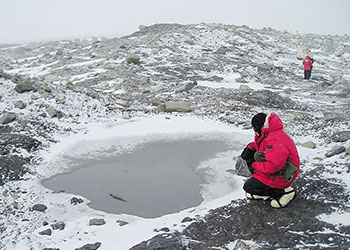New Evidence that Antarctic Ice Sheet was Very Vulnerable to Warm Climate in the Past:
Ice-Free Deserts near South Pole during Pliocene
Tao Sun Publishes Findings in Nature Communications
The Antarctic Sun, the official news for United States Antarctic Program, featured research conducted by University of Houston geochemist Tao Sun of the Center for Petroleum Geochemistry in the Department of Earth and Atmospheric Sciences. The Antarctic Sun article was titled “The Lost Dry Valleys of the Polar Plateau.”

Field observation of small melt-water pond and evaporite boulder in its vicinity,
Lewis Cliff Ice Tongue Moraine Ridges, Antarctica.Sun’s research is on the Antarctic Ice Sheet evolution. The work was recently presented
in the article “Lost Cold Antarctic Deserts Inferred from Unusual Sulfate Formation and Isotope Signatures” published in the high-impact journal, Nature Communications.
Sun and his colleagues examined salt formations from a young moraine on the polar-ward side of the Transantarctic Mountains. They found that the sulfate salts possess unusual stable isotope compositions which indicate they originated from near the South Pole, and their formation condition was similar to the ice-free McMurdo Dry Valleys.
The findings of Sun and his colleagues suggest that this set of new proxy for Antarctic Ice Sheet evolution indicate that the present-day ice-buried terrain near the South Pole became ice-free in response to climate warmth in the geological past. This conclusion supports the “dynamic nature” of the Antarctic Ice Sheet.
In addition to this important conclusion, their findings provide a number of ‘record-breaking’ sulfur and oxygen isotope compositions for sulfate on Earth, adding to our understanding of historical changes in the global sulfur cycle.
Abstract from Article in Nature Communications
The Antarctic ice cap significantly affects global ocean circulation and climate. Continental glaciogenic sedimentary deposits provide direct physical evidence of the glacial history of the Antarctic interior, but these data are sparse. Here we investigate a new indicator of ice sheet evolution: sulfates within the glaciogenic deposits from the Lewis Cliff Ice Tongue of the central Transantarctic Mountains. The sulfates exhibit unique isotope signatures, including δ34S up to +50‰ for mirabilite evaporites, Δ17O up to +2.3‰ for dissolved sulfate within contemporary melt-water ponds, and extremely negative δ18O as low as −22.2‰. The isotopic data imply that the sulfates formed under environmental conditions similar to today’s McMurdo Dry Valleys, suggesting that ice-free cold deserts may have existed between the South Pole and the Transantarctic Mountains since the Miocene during periods when the ice sheet size was smaller than today, but with an overall similar to modern global hydrological cycle.